Abstract
Although the long-neglected field of human susceptibility to environmental toxicants is currently receiving renewed attention, there is only scant literature on factors influencing susceptibility to heavy metals. Genetic factors may influence the availability of sulfhydryl-containing compounds such as glutathione and metallothionein, which modify the distribution and toxicity of certain metals. Age and gender play a role in modifying uptake and distribution, although the mechanisms are often obscure. Concurrent exposure to divalent cations may enhance or reduce the toxicity of certain metals through competition for receptor-mediated transport or targets. Increasing use of biomarkers of exposure should greatly increase our understanding of the underlying distribution of susceptibility to various environmental agents.
Full text
PDF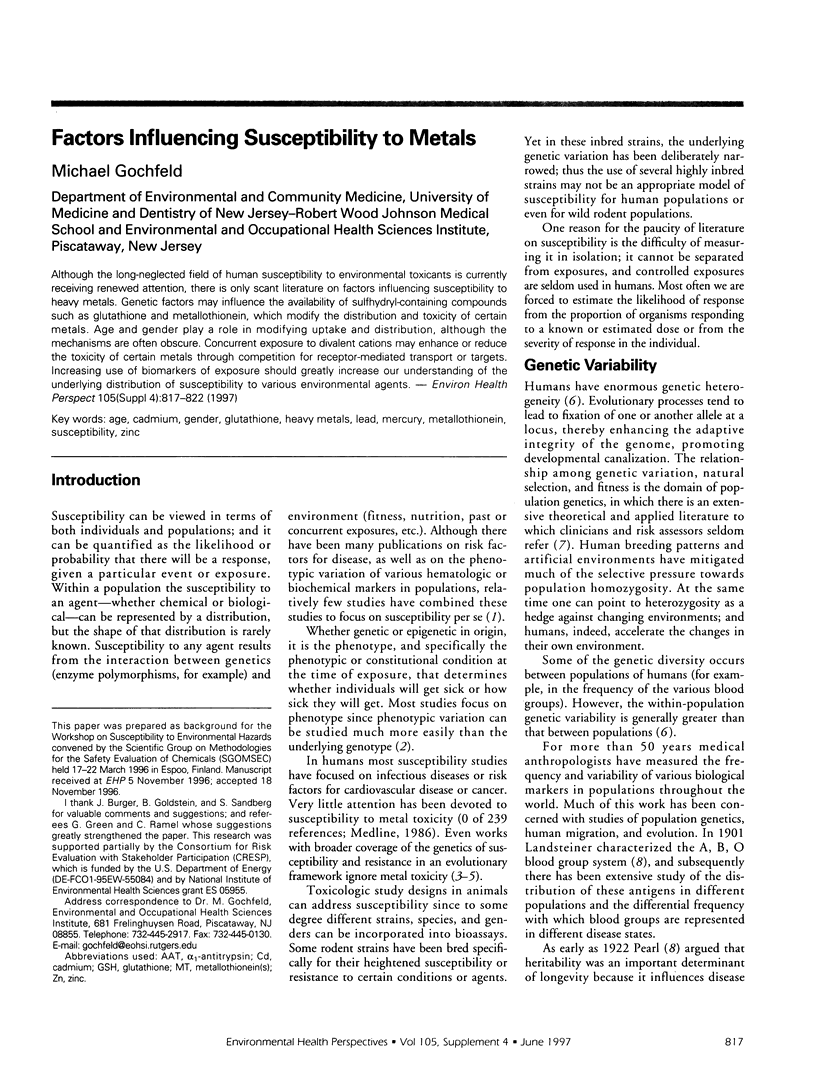
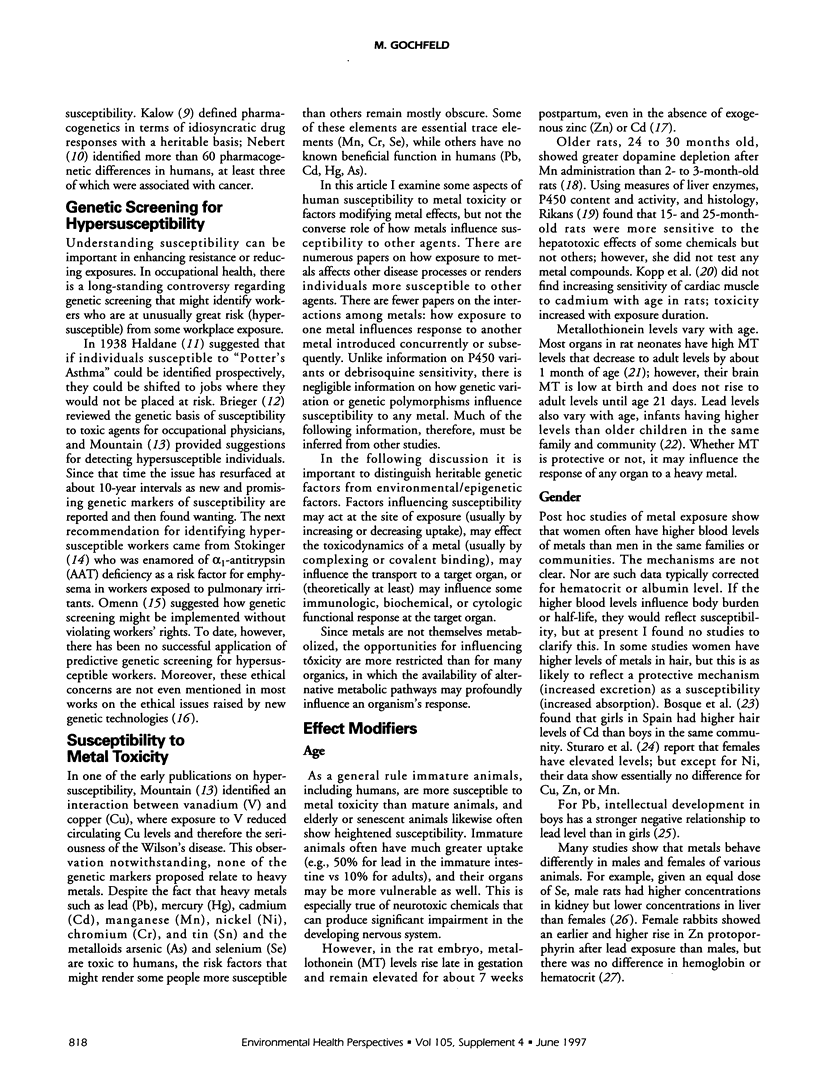
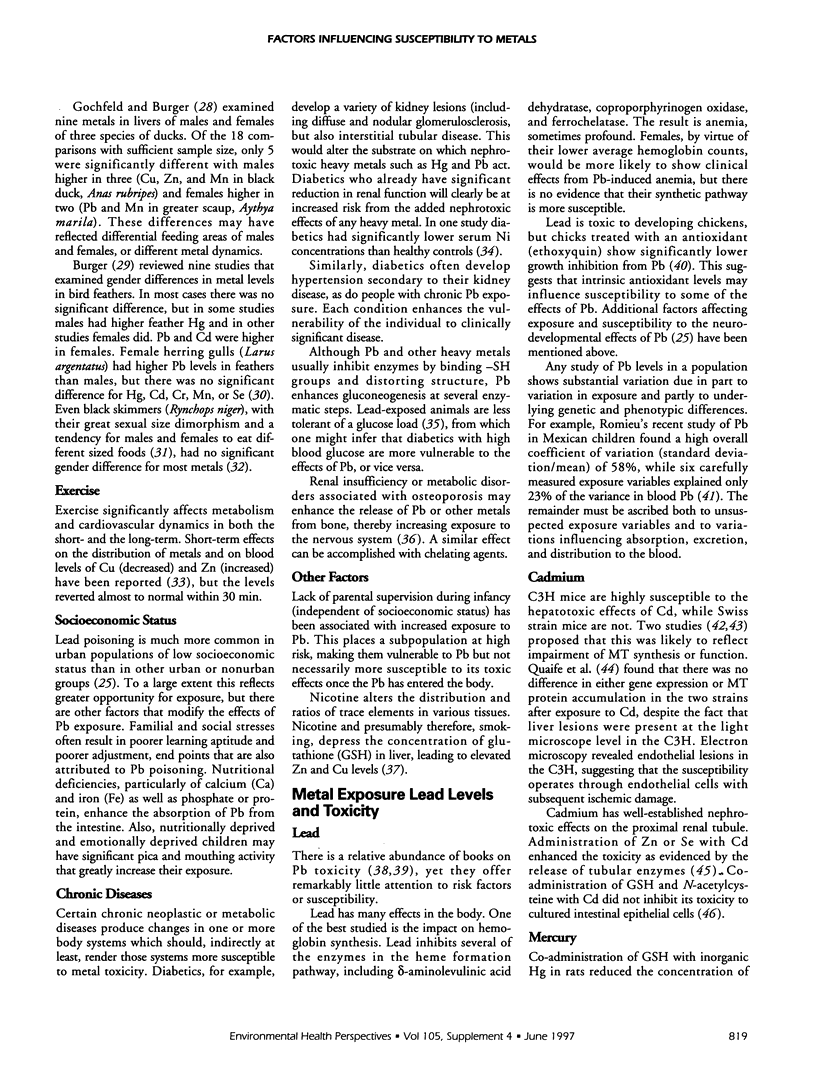
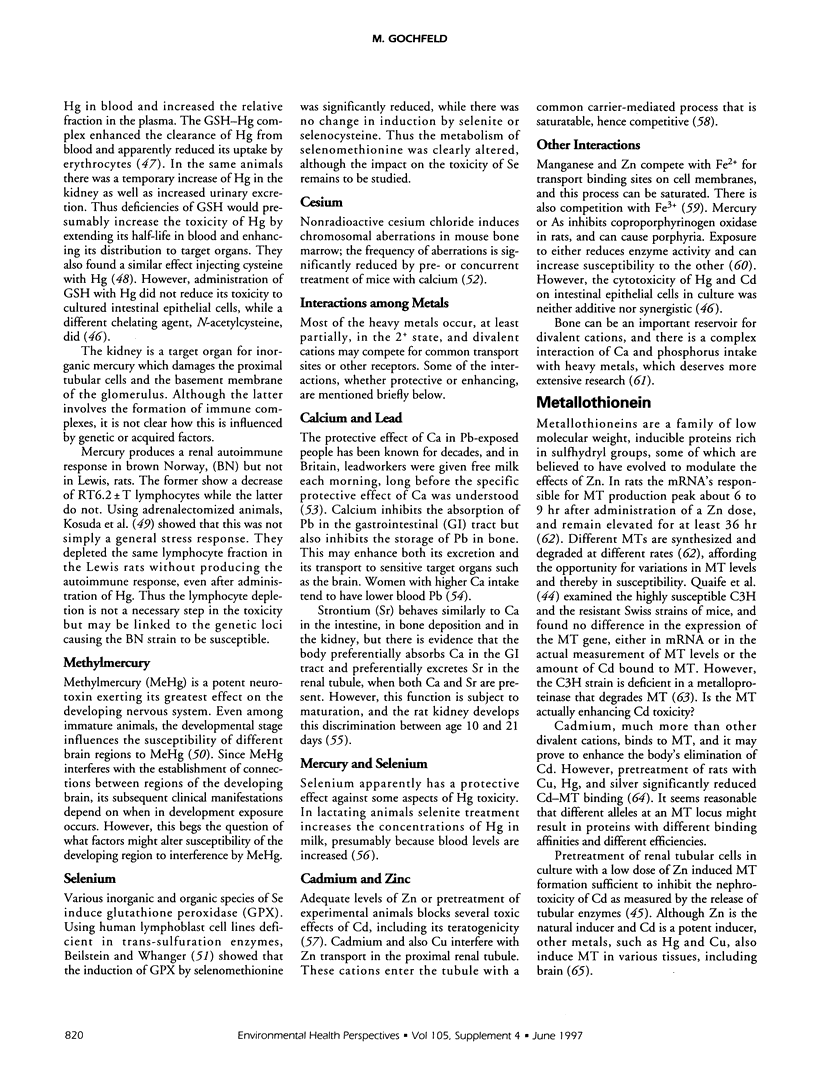
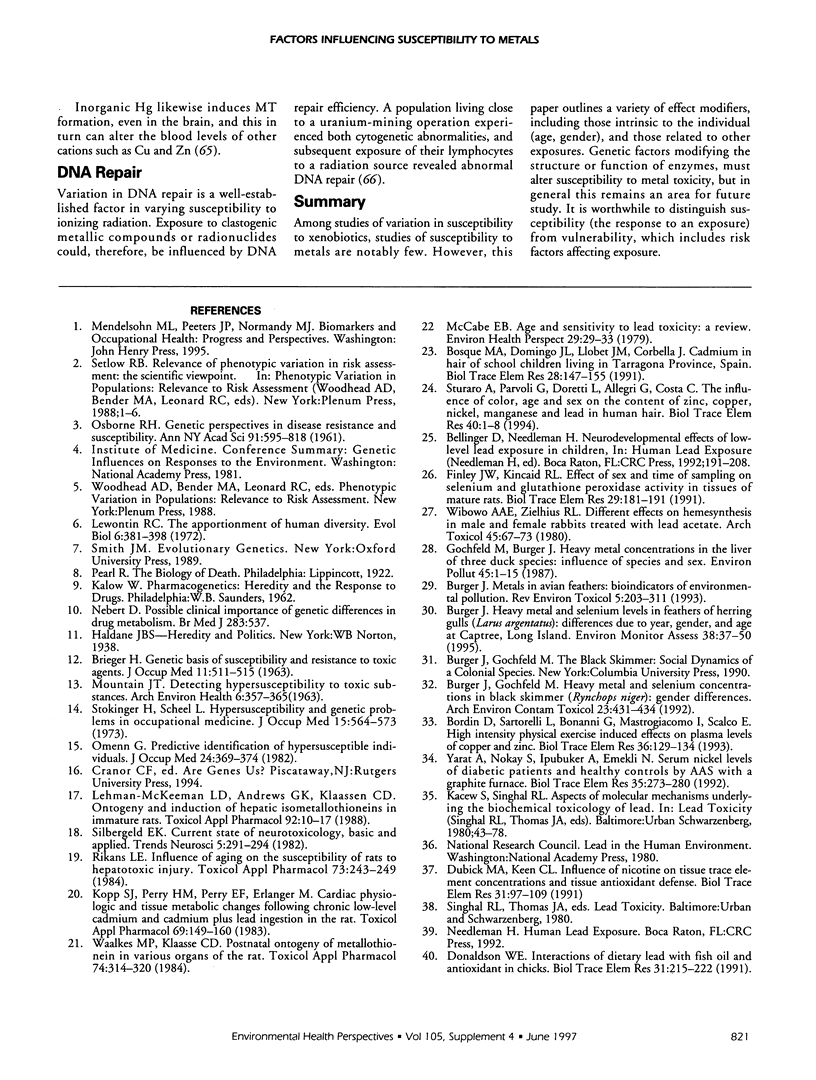
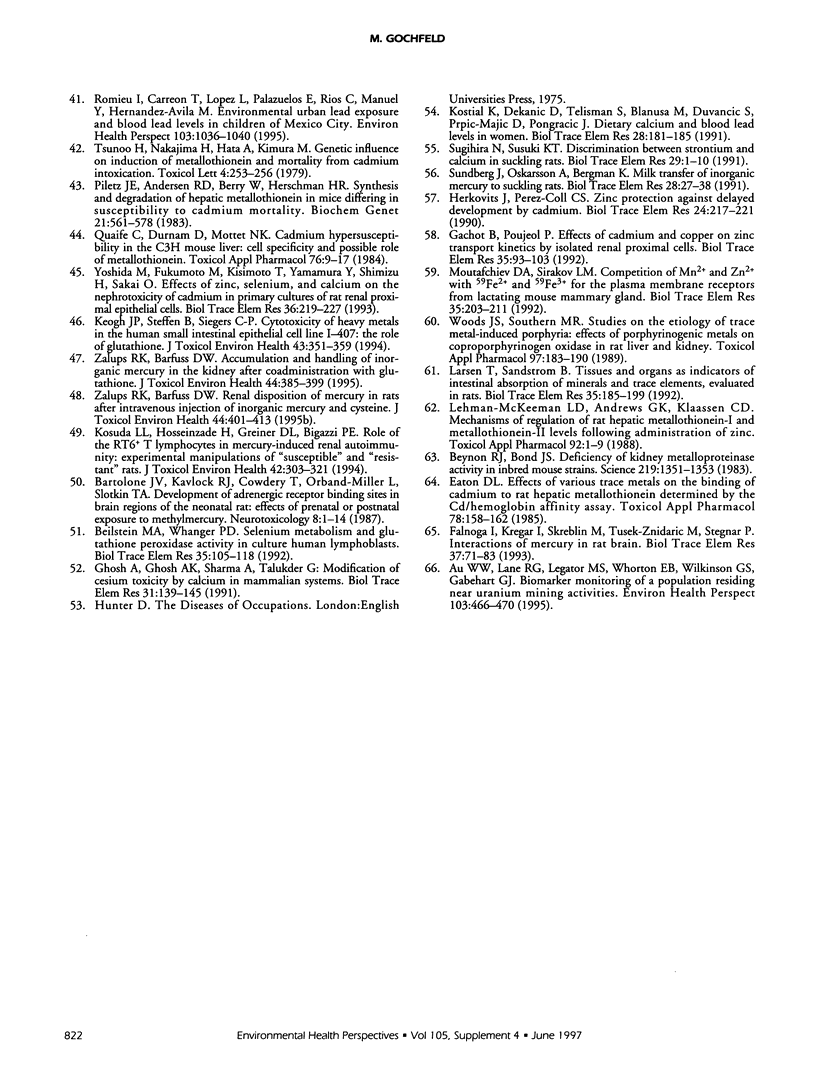
Selected References
These references are in PubMed. This may not be the complete list of references from this article.
- Au W. W., Lane R. G., Legator M. S., Whorton E. B., Wilkinson G. S., Gabehart G. J. Biomarker monitoring of a population residing near uranium mining activities. Environ Health Perspect. 1995 May;103(5):466–470. doi: 10.1289/ehp.95103466. [DOI] [PMC free article] [PubMed] [Google Scholar]
- BRIEGER H. GENETIC BASES OF SUSCEPTIBILITY AND RESISTANCE TO TOXIC AGENTS. J Occup Med. 1963 Nov;5:511–515. [PubMed] [Google Scholar]
- Bartolome J. V., Kavlock R. J., Cowdery T., Orband-Miller L., Slotkin T. A. Development of adrenergic receptor binding sites in brain regions of the neonatal rat: effects of prenatal or postnatal exposure to methylmercury. Neurotoxicology. 1987 Spring;8(1):1–13. [PubMed] [Google Scholar]
- Beilstein M. A., Whanger P. D. Selenium metabolism and glutathione peroxidase activity in cultured human lymphoblasts. Effects of transsulfuration defects and pyridoxal phosphate. Biol Trace Elem Res. 1992 Nov;35(2):105–118. doi: 10.1007/BF02783723. [DOI] [PubMed] [Google Scholar]
- Beynon R. J., Bond J. S. Deficiency of a kidney metalloproteinase activity in inbred mouse strains. Science. 1983 Mar 18;219(4590):1351–1353. doi: 10.1126/science.6338590. [DOI] [PubMed] [Google Scholar]
- Bordin D., Sartorelli L., Bonanni G., Mastrogiacomo I., Scalco E. High intensity physical exercise induced effects on plasma levels of copper and zinc. Biol Trace Elem Res. 1993 Feb;36(2):129–134. doi: 10.1007/BF02783171. [DOI] [PubMed] [Google Scholar]
- Bosque M. A., Domingo J. L., Llobet J. M., Corbella J. Cadmium in hair of school children living in Tarragona Province, Spain. Relationship to age, sex, and environmental factors. Biol Trace Elem Res. 1991 Feb;28(2):147–155. doi: 10.1007/BF02863080. [DOI] [PubMed] [Google Scholar]
- Burger J., Gochfeld M. Heavy metal and selenium concentrations in black skimmers (Rynchops niger): gender differences. Arch Environ Contam Toxicol. 1992 Nov;23(4):431–434. doi: 10.1007/BF00203805. [DOI] [PubMed] [Google Scholar]
- Donaldson W. E. Interactions of dietary lead with fish oil and antioxidant in chicks. Biol Trace Elem Res. 1991 Dec;31(3):215–222. doi: 10.1007/BF02990192. [DOI] [PubMed] [Google Scholar]
- Dubick M. A., Keen C. L. Influence of nicotine on tissue trace element concentrations and tissue antioxidant defense. Biol Trace Elem Res. 1991 Nov;31(2):97–109. doi: 10.1007/BF02990418. [DOI] [PubMed] [Google Scholar]
- Eaton D. L. Effects of various trace metals on the binding of cadmium to rat hepatic metallothionein determined by the Cd/hemoglobin affinity assay. Toxicol Appl Pharmacol. 1985 Mar 30;78(1):158–162. doi: 10.1016/0041-008x(85)90315-1. [DOI] [PubMed] [Google Scholar]
- Falnoga I., Kregar I., Skreblin M., Tusek-Znidaric M., Stegnar P. Interactions of mercury in rat brain. Biol Trace Elem Res. 1993 Apr;37(1):71–83. doi: 10.1007/BF02789402. [DOI] [PubMed] [Google Scholar]
- Finley J. W., Kincaid R. L. Effect of sex and time of sampling on selenium and glutathione peroxidase activity in tissues of mature rats. Biol Trace Elem Res. 1991 Jun;29(3):181–191. doi: 10.1007/BF03032676. [DOI] [PubMed] [Google Scholar]
- Gachot B., Poujeol P. Effects of cadmium and copper on zinc transport kinetics by isolated renal proximal cells. Biol Trace Elem Res. 1992 Nov;35(2):93–103. doi: 10.1007/BF02783722. [DOI] [PubMed] [Google Scholar]
- Ghosh A., Ghosh A. K., Sharma A., Talukder G. Modification of cesium toxicity by calcium in mammalian system. Biol Trace Elem Res. 1991 Nov;31(2):139–145. doi: 10.1007/BF02990422. [DOI] [PubMed] [Google Scholar]
- Gochfeld M., Burger J. Heavy metal concentrations in the liver of three duck species: influence of species and sex. Environ Pollut. 1987;45(1):1–15. doi: 10.1016/0269-7491(87)90012-1. [DOI] [PubMed] [Google Scholar]
- Herkovits J., Pérez-Coll C. S. Zinc protection against delayed development produced by cadmium. Biol Trace Elem Res. 1990 Mar;24(3):217–221. doi: 10.1007/BF02917209. [DOI] [PubMed] [Google Scholar]
- Keogh J. P., Steffen B., Siegers C. P. Cytotoxicity of heavy metals in the human small intestinal epithelial cell line I-407: the role of glutathione. J Toxicol Environ Health. 1994 Nov;43(3):351–359. doi: 10.1080/15287399409531926. [DOI] [PubMed] [Google Scholar]
- Kopp S. J., Perry H. M., Jr, Perry E. F., Erlanger M. Cardiac physiologic and tissue metabolic changes following chronic low-level cadmium and cadmium plus lead ingestion in the rat. Toxicol Appl Pharmacol. 1983 Jun 15;69(1):149–160. doi: 10.1016/0041-008x(83)90131-x. [DOI] [PubMed] [Google Scholar]
- Kostial K., Dekanić D., Telisman S., Blanusa M., Duvancić S., Prpić-Majić D., Pongracić J. Dietary calcium and blood lead levels in women. Biol Trace Elem Res. 1991 Mar;28(3):181–185. doi: 10.1007/BF02990465. [DOI] [PubMed] [Google Scholar]
- Kosuda L. L., Hosseinzadeh H., Greiner D. L., Bigazzi P. E. Role of RT6+ T lymphocytes in mercury-induced renal autoimmunity: experimental manipulations of "susceptible" and "resistant" rats. J Toxicol Environ Health. 1994 Jul;42(3):303–321. doi: 10.1080/15287399409531881. [DOI] [PubMed] [Google Scholar]
- Larsen T., Sandström B. Tissues and organs as indicators of intestinal absorption of minerals and trace elements, evaluated in rats. Biol Trace Elem Res. 1992 Nov;35(2):185–199. doi: 10.1007/BF02783729. [DOI] [PubMed] [Google Scholar]
- Lehman-McKeeman L. D., Andrews G. K., Klaassen C. D. Mechanisms of regulation of rat hepatic metallothionein-I and metallothionein-II levels following administration of zinc. Toxicol Appl Pharmacol. 1988 Jan;92(1):1–9. doi: 10.1016/0041-008x(88)90221-9. [DOI] [PubMed] [Google Scholar]
- Lehman-McKeeman L. D., Andrews G. K., Klaassen C. D. Ontogeny and induction of hepatic isometallothioneins in immature rats. Toxicol Appl Pharmacol. 1988 Jan;92(1):10–17. doi: 10.1016/0041-008x(88)90222-0. [DOI] [PubMed] [Google Scholar]
- MOUNTAIN J. T. Detecting hypersusceptibility to toxic substances. An appraisal of simple blood test. Arch Environ Health. 1963 Mar;6:357–365. doi: 10.1080/00039896.1963.10663406. [DOI] [PubMed] [Google Scholar]
- Moutafchiev D. A., Sirakov L. M. Competition of Mn2+ and Zn2+ with 59Fe2+ and 59Fe3+ for the plasma membrane receptors from lactating mouse mammary gland. Biol Trace Elem Res. 1992 Dec;35(3):203–211. doi: 10.1007/BF02783766. [DOI] [PubMed] [Google Scholar]
- Nebert D. W. Clinical pharmacology. Possible clinical importance of genetic differences in drug metabolism. Br Med J (Clin Res Ed) 1981 Aug 22;283(6290):537–542. doi: 10.1136/bmj.283.6290.537. [DOI] [PMC free article] [PubMed] [Google Scholar]
- Omenn G. S. Predictive identification of hypersusceptible individuals. J Occup Med. 1982 May;24(5):369–374. doi: 10.1097/00043764-198205000-00007. [DOI] [PubMed] [Google Scholar]
- Piletz J. E., Andersen R. D., Berry W., Herschman H. R. Synthesis and degradation of hepatic metallothionein in mice differing in susceptibility to cadmium mortality. Biochem Genet. 1983 Jun;21(5-6):561–578. doi: 10.1007/BF00484447. [DOI] [PubMed] [Google Scholar]
- Quaife C., Durnam D., Mottet N. K. Cadmium hypersusceptibility in the C3H mouse liver: cell specificity and possible role of metallothionein. Toxicol Appl Pharmacol. 1984 Oct;76(1):9–17. doi: 10.1016/0041-008x(84)90024-3. [DOI] [PubMed] [Google Scholar]
- Rikans L. E. Influence of aging on the susceptibility of rats to hepatotoxic injury. Toxicol Appl Pharmacol. 1984 Apr;73(2):243–249. doi: 10.1016/0041-008x(84)90329-6. [DOI] [PubMed] [Google Scholar]
- Romieu I., Carreon T., Lopez L., Palazuelos E., Rios C., Manuel Y., Hernandez-Avila M. Environmental urban lead exposure and blood lead levels in children of Mexico City. Environ Health Perspect. 1995 Nov;103(11):1036–1040. doi: 10.1289/ehp.951031036. [DOI] [PMC free article] [PubMed] [Google Scholar]
- Stokinger H. E., Scheel L. D. Hypersusceptibility and genetic problems in occupational medicine--a consensus report. J Occup Med. 1973 Jul;15(7):564–573. [PubMed] [Google Scholar]
- Sturaro A., Parvoli G., Doretti L., Allegri G., Costa C. The influence of color, age, and sex on the content of zinc, copper, nickel, manganese, and lead in human hair. Biol Trace Elem Res. 1994 Jan;40(1):1–8. doi: 10.1007/BF02916815. [DOI] [PubMed] [Google Scholar]
- Sugihira N., Suzuki K. T. Discrimination between strontium and calcium in suckling rats. Biol Trace Elem Res. 1991 Apr;29(1):1–10. doi: 10.1007/BF03032669. [DOI] [PubMed] [Google Scholar]
- Sundberg J., Oskarsson A., Bergman K. Milk transfer of inorganic mercury to suckling rats. Interaction with selenite. Biol Trace Elem Res. 1991 Jan;28(1):27–38. doi: 10.1007/BF02990460. [DOI] [PubMed] [Google Scholar]
- Waalkes M. P., Klaassen C. D. Postnatal ontogeny of metallothionein in various organs of the rat. Toxicol Appl Pharmacol. 1984 Jul;74(3):314–320. doi: 10.1016/0041-008x(84)90284-9. [DOI] [PubMed] [Google Scholar]
- Wibowo A. A., Zielhuis R. L. Different effects on hemesynthesis in male and female rabbits treated with lead acetate. Arch Toxicol. 1980 May;45(1):67–73. doi: 10.1007/BF00303297. [DOI] [PubMed] [Google Scholar]
- Woods J. S., Southern M. R. Studies on the etiology of trace metal-induced porphyria: effects of porphyrinogenic metals on coproporphyrinogen oxidase in rat liver and kidney. Toxicol Appl Pharmacol. 1989 Jan;97(1):183–190. doi: 10.1016/0041-008x(89)90067-7. [DOI] [PubMed] [Google Scholar]
- Yarat A., Nokay S., Ipbüker A., Emekli N. Serum nickel levels of diabetic patients and healthy controls by AAS with a graphite furnace. Biol Trace Elem Res. 1992 Dec;35(3):273–280. doi: 10.1007/BF02783771. [DOI] [PubMed] [Google Scholar]
- Zalups R. K., Barfuss D. W. Accumulation and handling of inorganic mercury in the kidney after coadministration with glutathione. J Toxicol Environ Health. 1995 Apr;44(4):385–399. doi: 10.1080/15287399509531968. [DOI] [PubMed] [Google Scholar]
- Zalups R. K., Barfuss D. W. Renal disposition of mercury in rats after intravenous injection of inorganic mercury and cysteine. J Toxicol Environ Health. 1995 Apr;44(4):401–413. doi: 10.1080/15287399509531969. [DOI] [PubMed] [Google Scholar]


